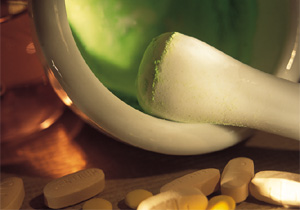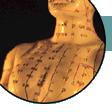|
 |
Introduction to TCM

Basics of TCM

• Yin-Yang | Five Elements

Zang-Fu Theories

• Zang Organs | Fu Organs

Classification of Antineoplastic Herbal Medicines

Characteristics of Herbal Medicines

Diagnose

• By Auscultation & Olfaction
• By Inspection

Prescriptions

Theories of Channels (Meridians) and Collaterals

Reference: A Modern View of the Immune System

Differentiation of Syndromes

• 8 Principles
• 6 Channels 4 Stages
• Syndromes of Zang-Fu Organs

Etiology

• Exogenous
| Pestilential
• Pathogenic Factors
• Emotional

Materia Medica


Back to Home

|
 |

Classification of Antineoplastic Herbal Medicines
The classification of antineoplastic herbal medicines here
is based on their effects as categorized by the traditional theories,
it is necessary to relate here why, according to the principle of
traditional Chinese medicine (TCM) that herbal medicines with various
pharmacologic effects can act as an antineoplastic agent.
General Classification
1. herbal medicines with heat and toxin clearing action
2. herbal medicines with blood-regulating action
3. herbal medicines with phlegm-removing action
4. herbal medicines with diuretic and dampness-eliminating action
5. herbal medicines for external application
Herbal Medicines with Heat and Toxin Clearing Action
Generally speaking, the herbal medicines with heat and toxin
clearing action are prescribed for illness displaying heat-toxin
syndrome. Some of the patients suffering from neoplasm manifest
as suffering from heat-syndrome, such as fever, thirst, deep-colored
urine, red tongue, rapid pulse, etc. At the same time, signs of
heat-toxin retention are shown, for example, necrosis and secretion
of stinking tumor mass; foul dirty vaginal discarge in cervical
carcinoma cases; purulent and bloody stool in colonic carcinoma
cases; hematemesis, epistaxis and subcutaneous hemorrhage in
leukemia cases; jaundice, hematemesis and hemafecia in hepatic
carcinoma cases; and so on. The herbal medicines in this category
are effective for relieving the heat-toxin syndrome hich appears in
the patients suffering from neoplasm.
Herbal Medicines with Blood-regulating Action
The herbal medicines with blood-regulating action serve to activate
blood circulation and eliminate blood-stasis, or to stop bleeding. In
some of the patients suffering from neoplasm, there may be a palpable
mass with localized pain and accompanied by a diminshed complexion, a
dull tongue with petechiae or ecchymoses, and an engorged sublingual vein.
These signify a blood-stasis syndrome. The herbal medicines with
blood-circulation activating and blood-stasis eliminating action can
remove the blood stagnation so as to dissipate the tumor and to
relieve pain. Furthermore, hemorrhage may also be seen in the
neoplastic cases, which is caused by blood-heat, blood-stasis, or
blood extravasation due to heat. For these cases, the herbal medicines
with hemostatic effect not only serve as a symptomatic treatment but
also as a causative treatment for cooling the blood, purging fire and
eliminating blood-stasis.
Herbal Medicines with Phlegm-removing Action
The herbal medicines with phlegm-removing action serve to eliminate
the secreation of resporatory tract and the phlegm elsewhere. As the
term phlegm in TCM is rather broad, the manifestation of phlegm-syndrome
varies with different locations in which the phlegm accumulates. When
it is accumulated in the lung, the case may mainfest as dyspneic cough
with expectoration (e.g. lung cancer); in the stomach, as nausea,
vomiting and epigastric fullness (e.g. gastric cancer); in the
meridians and subcutaneous tissues, as scrofula and subcutaneous
nodules (e.g. cervical lymphoma, cervical metastatic cancer, mammary
carcinoma, etc.); in the brain, as dizziness or disturbance of
consciousness (e.g. brain tumor). Hence, the herbal medicines of this
kind may serve to relieve the phlegm-syndrome occurring in the
neoplastic cases.
Herbal Medicines with Diuretic and Dampness-eliminating Action
The herbal medicines with diuretic and dampness-eliminating action
are applied to cases with retention of fluid and dampness. Some of
the patients suffering from neoplasm show a fluid-retention or
dampness-accumulation syndrome, manifesting as edema, ascites,
leucorrhagia, diarrhea, or dysuria and associated with a corpulent
tongue covered by thick turbid and smooth fur. The herbal medicines
in this category can relievesuch disorders occurring in the patients.
Herbal Medicines with Tonic Effects
The herbal medicines with tonic effects are used to treat
asthenia-syndrome cases with manifest as insufficiency of vital energy,
blood, yin or yang. Because debility and deficiency of healthy energy
is one of the important causes responsible for tumorigenesis, and
a neoplasm already developed may further impair the healthy energy,
so the patients suffering from neoplasm usually display an
asthenia-syndrome. The application of tonics may enhance the body
resistance and is certainly beneficial to the antineoplastic therapy.
In fact, it has been found that many herbal medicines with tonic effects
can promote the immunologic, hemopoietic as well as digestive functions
of the body, and some of them even serve as an inhibitor or killer of
the tumor cells. When applying this kind of herbal medicines, the
principle of trestment in line with syndrome differentiation should
be followed, and the medicines selected for use should match with
the attribution of asthenia-syndrome (i.e., whether it is asthenia
of vital energy, blood, yin-yang, or one of the viscera).
Herbal Medicines for External Application
The herbal medicines for external application are generally erosive
and poisonous, and their dosages should be strictly handled. They are
applied on the surface of tumor, or as an infiltrate into the mass or
around its base, to induce necrosis and exfoliation of the tumor.
Read also Characteristics of Herbal Medicines
|

|
|
|
|
|
 |

|
WHAT IS TRADITIONAL CHINESE MEDICINE?

Photo © Image DJ Image Dictionary
With over 3000 years of experience, Traditional Chinese Medicine (TCM) has
remain one of the many fascinating areas in ancient Chinese culture.
First known to be documented in the Yellow Emperor's Canon of Medicine,
TCM is believed to have been practised in as early as 475 to 221 B.C.
The field of working knowledge of TCM stretches from anything related to
general healthcare practice to the philosophy of the mind, the logic of life,
religion, and even to as far as cosmology and astronumerology. This is why
in order to thoroughly understand the concepts behind TCM, one must be
comprehensive in learning and embracing the Chinese culture as a whole.
Just as Douglas Hoff put it when he explained about accupuncture, "The systems
of TCM uses the concepts of elements and meridians and are completely immersed
in the Asian cosmology which takes shape through the religions." The meridian-brain mechanism,
the fundamental working concept of acupuncture, in which the pain block from the message
that the needle or burning cone of herbs gives to the point of stimulus,
was only found centuries later by the West through science and technology.
|
| |
|
MESSAGE FROM THE EDITOR – MARCH 2020
 Thank you for visiting this TCM and acupuncture information website.
If you have previously been to this website, you might have
noticed that some of the pages on ancient historical ideas and
holistic thinkings related to Chinese metaphysics are temporarily taken offline.
This is because I will be revamping the whole website and be moving
those information into a new \"Ancient Chinese Culture\" section
so as to reflect a more current perspective on the interpretation
of some of the fundamental concepts as well as to include
some of the latest information in the area.
But if you have just found this website for the very first time, I welcome you again and
wish you could find what you require and, hopefully, you could also be benefitted
from reading the articles I published on this website.
Thank you for visiting this TCM and acupuncture information website.
If you have previously been to this website, you might have
noticed that some of the pages on ancient historical ideas and
holistic thinkings related to Chinese metaphysics are temporarily taken offline.
This is because I will be revamping the whole website and be moving
those information into a new \"Ancient Chinese Culture\" section
so as to reflect a more current perspective on the interpretation
of some of the fundamental concepts as well as to include
some of the latest information in the area.
But if you have just found this website for the very first time, I welcome you again and
wish you could find what you require and, hopefully, you could also be benefitted
from reading the articles I published on this website.
Please be patient and do come and check out this website frequently as it's being revamped.
Raymond Cheng, PhD DPA FRSA FRSPH

March 28, 2020.
|

|
IMPORTANT NOTICE AND DISCLAIMER

 This website is published, edited and designed by Raymond Cheng,
and reflects only and only his personal views and opinions in his individual capacity.
The information available at this website is not intended
directly or by implication to either diagnose or treat any
medical, emotional, or psychological condition or disorder.
It is also not intended to create a physician-patient relationship
between you and I or between you and Wyith Institute™ and The Office of Dr Raymond K K Cheng.
The information here is not a substitute for advice and treatment provided
by your physician or by another healthcare professional.
It is always recommended that consultation with local healthcare providers
be obtained for any of your specific health or medical concerns.
Furthermore, any products that can be purchased (yet you can see I don't have much
to sell here) through advertisers' banners or through links to other websites
are not either explicitly or implicitly given any warranty or endorsement
by me, my colleagues, Wyith Institute™ or any of its associated businesses.
This website is published, edited and designed by Raymond Cheng,
and reflects only and only his personal views and opinions in his individual capacity.
The information available at this website is not intended
directly or by implication to either diagnose or treat any
medical, emotional, or psychological condition or disorder.
It is also not intended to create a physician-patient relationship
between you and I or between you and Wyith Institute™ and The Office of Dr Raymond K K Cheng.
The information here is not a substitute for advice and treatment provided
by your physician or by another healthcare professional.
It is always recommended that consultation with local healthcare providers
be obtained for any of your specific health or medical concerns.
Furthermore, any products that can be purchased (yet you can see I don't have much
to sell here) through advertisers' banners or through links to other websites
are not either explicitly or implicitly given any warranty or endorsement
by me, my colleagues, Wyith Institute™ or any of its associated businesses.
|

|
|

 This website is published, edited and designed by Raymond Cheng,
and reflects only and only his personal views and opinions in his individual capacity.
The information available at this website is not intended
directly or by implication to either diagnose or treat any
medical, emotional, or psychological condition or disorder.
It is also not intended to create a physician-patient relationship
between you and I or between you and Wyith Institute™ and The Office of Dr Raymond K K Cheng.
The information here is not a substitute for advice and treatment provided
by your physician or by another healthcare professional.
It is always recommended that consultation with local healthcare providers
be obtained for any of your specific health or medical concerns.
Furthermore, any products that can be purchased (yet you can see I don't have much
to sell here) through advertisers' banners or through links to other websites
are not either explicitly or implicitly given any warranty or endorsement
by me, my colleagues, Wyith Institute™ or any of its associated businesses.
This website is published, edited and designed by Raymond Cheng,
and reflects only and only his personal views and opinions in his individual capacity.
The information available at this website is not intended
directly or by implication to either diagnose or treat any
medical, emotional, or psychological condition or disorder.
It is also not intended to create a physician-patient relationship
between you and I or between you and Wyith Institute™ and The Office of Dr Raymond K K Cheng.
The information here is not a substitute for advice and treatment provided
by your physician or by another healthcare professional.
It is always recommended that consultation with local healthcare providers
be obtained for any of your specific health or medical concerns.
Furthermore, any products that can be purchased (yet you can see I don't have much
to sell here) through advertisers' banners or through links to other websites
are not either explicitly or implicitly given any warranty or endorsement
by me, my colleagues, Wyith Institute™ or any of its associated businesses.



 Thank you for visiting this TCM and acupuncture information website.
If you have previously been to this website, you might have
noticed that some of the pages on ancient historical ideas and
holistic thinkings related to Chinese metaphysics are temporarily taken offline.
This is because I will be revamping the whole website and be moving
those information into a new \"Ancient Chinese Culture\" section
so as to reflect a more current perspective on the interpretation
of some of the fundamental concepts as well as to include
some of the latest information in the area.
But if you have just found this website for the very first time, I welcome you again and
wish you could find what you require and, hopefully, you could also be benefitted
from reading the articles I published on this website.
Thank you for visiting this TCM and acupuncture information website.
If you have previously been to this website, you might have
noticed that some of the pages on ancient historical ideas and
holistic thinkings related to Chinese metaphysics are temporarily taken offline.
This is because I will be revamping the whole website and be moving
those information into a new \"Ancient Chinese Culture\" section
so as to reflect a more current perspective on the interpretation
of some of the fundamental concepts as well as to include
some of the latest information in the area.
But if you have just found this website for the very first time, I welcome you again and
wish you could find what you require and, hopefully, you could also be benefitted
from reading the articles I published on this website.